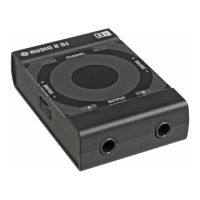AUDIO 2 DJ – 46
11.3 About Samples and Buffers
Audio cannot be handled continuously by a computer, but has to wait its turn while other
operations are being carried out. As a result, sound cards create a “buffer,” which can
hold a certain number of samples, where data can be stored and released as needed to
create a smooth ow of data. An analogy would be if you had a hose that does not deliver
water continuously, but in bursts. So you use a holding tank to store the water coming in
from the hose and have a valve in the tank that releases a steady amount of water in a
smooth, continuous ow.
If the tank (buffer) is large, then you can store more water in case the hose goes dry for a
bit. But it will take longer to ll the bucket, which is equivalent to latency. A smaller tank
takes less time to ll, but the hose needs to deliver water on a pretty continuous basis.
All ASIO audio interfaces and sound cards include a Control Panel in which you can adjust
latency. This may be given as the number of samples per buffer or just milliseconds.
The AUDIO 2 DJ provides you with several predened settings (in milliseconds) to choose
from and the option to user-dene the values.
Open Start > All Programs > Native Instruments > Audio 2 DJ Driver > Control Panel.
Read more about the Control Panel of the AUDIO 2 DJ in chapter 8 “Understanding the
Control Panel.”
11.4 Different Types of ASIO
It is extremely important to use the ASIO driver written for the AUDIO 2 DJ. There are
also generic ASIO drivers, typically called (for Windows) ASIO DirectX Full Duplex Driver
or ASIO Multimedia Driver. If you’re not sure which one to use, try them all, and choose
the one with the lowest latency.

